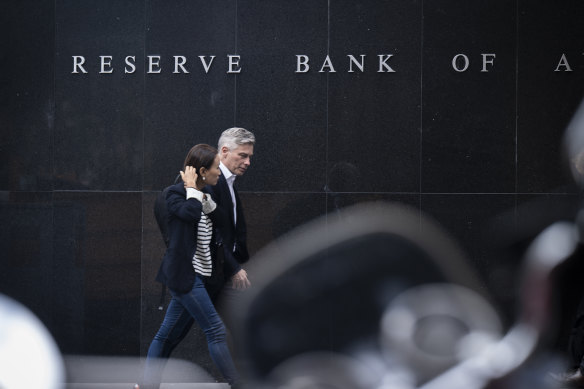Banking giants CBA, ANZ on board for RBA’s digital currency pilots
Financial giants including the Commonwealth and ANZ banks will work with the Reserve Bank to test the potential economic gains that could arise from giving consumers and businesses access to a new form of digital money.
The Reserve Bank on Thursday announced a series of trials for a retail central bank digital currency (CBDC), a type of digital dollar that does not exist in Australia, but is attracting growing attention in the industry globally.
The RBA has announced 14 pilot projects that would involve using real money in a central bank digital currency form.Credit:Louie Douvis
CBDCs would be akin to digital banknotes, and the RBA has previously referred to the concept as an “e-AUD”. They would be a direct claim on the RBA, in contrast to deposits that consumers currently have in bank accounts, which are claims on commercial banks.
Central banks around the world have been increasing research in this area as they explore the potential for innovation, and try to protect government-backed money against the disruptive threat from cryptocurrencies.
In a significant step, the RBA announced 14 pilot projects aimed at testing the use of real money in a CBDC form, involving banks and a range of other players in the industry.
The pilots, which will take place over the coming months, will test how CBDCs could be used to solve real-world problems.
‘There’s not a major economy in the globe that’s not looking at what could a future where there’s a CBDC look like.’
The projects will experiment with using CBDCs to deal with a range of issues, including cutting delays in international payments, helping small businesses with onerous GST paperwork, and providing people with “digital cash” that would work without access to banking infrastructure.
CBA’s managing director of blockchain and digital assets, Sophie Gilder, said she thought Australia would ultimately adopt some form of CBDC in about seven to 10 years.
Gilder said the purpose of the project was to learn about how CBDCs could be applied in the real world, including understanding regulatory issues that might arise. The pilots were more than theoretical as CBA would be using real money.
“The money is real – it’s converted into a new format,” Gilder said.
The RBA has previously said that introducing a retail CBDC would be “revolutionary” and it is not convinced of the case for a retail CBDC.
However, Gilder said there was a global push from central banks to investigate CBDCs.
“There’s not a major economy in the globe that’s not looking at what could a future where there’s a CBDC look like,” she said. “Australia is not likely to lead in this space, we are more likely to follow.”
In one pilot program, CBA will test how CBDCs could be used to automate business activity statements, which businesses that collect GST must regularly file with the tax office.
ANZ and CBA are also working together to test how nature-based assets such as carbon credits could be traded more efficiently through “tokenisation”, which involves creating digital representations of real-world assets.
In another pilot program, ANZ will attempt to show how CBDCs could provide a form of “digital cash”, even when there is no online connectivity, such as when there is a major outage.
The RBA’s assistant governor for the financial system, Brad Jones, welcomed the engagement from the industry and highlighted the range of players involved in the trials, including big banks and fintechs.
“The pilot and broader research study that will be conducted in parallel will serve two ends – it will contribute to hands-on learning by industry, and it will add to policymakers’ understanding of how a CBDC could potentially benefit the Australian financial system and economy,” Jones said.
The Business Briefing newsletter delivers major stories, exclusive coverage and expert opinion. Sign up to get it every weekday morning.
Most Viewed in Business
From our partners
Source: Read Full Article


